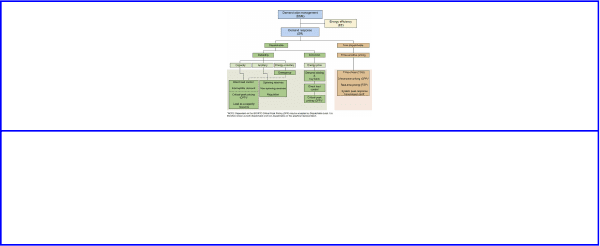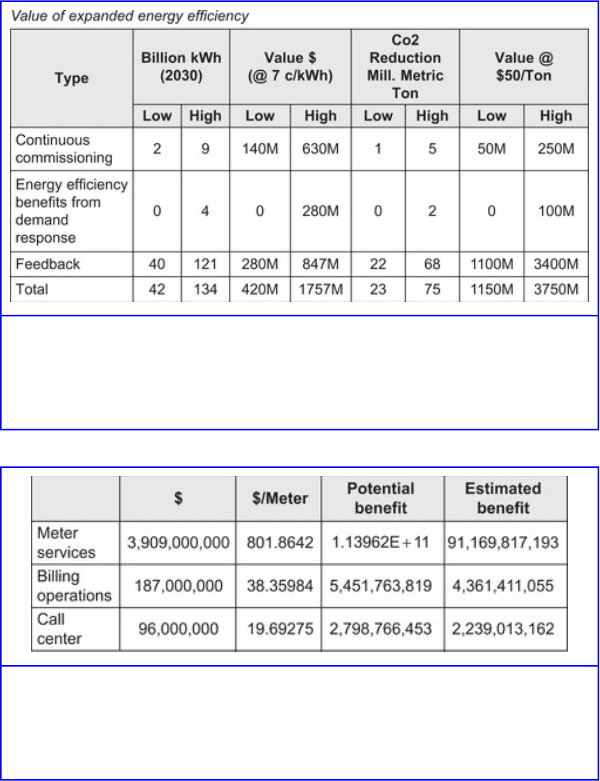Sioshansi F.P. Smart Grid: Integrating Renewable, Distributed & Efficient Energy
Подождите немного. Документ загружается.

electric vehicles, appliances, and other
household devices. (EPRI, 2011)
Smart grid technologies are best viewed in a system context.
In such a framework, one might view Smart Grid
technologies in terms of what they enable. Smart Grid
technologies are expected to enable the following kinds of
actions, improvements, and related benefits:
• Increase customer participation in energy usage. The
smart grid can provide consumers information that helps
them modify how they use and purchase electricity. It can
provide them choices, incentives, and disincentives in their
purchasing patterns and behavior, which in turn can help
drive new technologies and markets.
• Accommodate diverse generation and storage
technologies. These power generation options range from
centralized power plants to distributed energy resources
(DER) such as system aggregators, grid-scale power
projects like wind farms, and building-scale DER such as
solar PV or combined heat and power (CHP) systems.
Storage systems of various kinds would also be integrated
into a mature smart grid system.
• Enable markets for new products and services. A
smart grid can help enable markets that give consumers
greater access to competitively provided energy and related
services, from unregulated power purchasing to enhanced
information, communication, and control features.
• Improve power quality. Smart grid technologies, if
deployed in an integrated power grid, can improve the
reliability and quality of power supply. With digital
technologies increasingly ubiquitous, uninterrupted power
681
supply with consistent voltage, frequency, and related
characteristics is increasingly important to individual
homes and business operations as well as the productivity
of the economy as a whole.
• Improve utility system asset utilization and operating
efficiency. A smart grid helps manage customer loads and
system assets in a more coordinated fashion, such that the
system can provide more useful energy services from its
total asset base. It also reduces system inefficiencies and
operating costs.
• Minimize outages and system disruptions. A smart grid
can be self-healing to a greater extent than current power
grid technologies permit. It identifies and reacts to system
disturbances, using largely automated mitigation methods
that enable problems to be isolated, analyzed, and restored
with little human interaction. It can use predictive analysis
to detect existing and future problems and initiate
corrective actions.
• Improve system security and resilience. Smart grid
designs can resist both physical and cyber attacks. Sensing,
surveillance, switching, and intelligent detection, analysis
and control software can be built into grid operations to
detect and respond to threats. This can make grid systems
more resilient, with self-healing technologies that can
respond faster and with less impact to human-made and
natural incidents.
Another way of looking at these SG benefits from the utility
perspective is to list the potential value propositions to the
utility, including enabling a host of functionalities, features,
and services that are not currently feasible:
682
• Dispatchable load
• Generation investment deferral
• Reduced need to raise capital
• Increased diversity of the supply portfolio
• Reduction in net power costs
• Non-spinning reserves
• Market price mitigation (wholesale)
• Customer satisfaction improvement
• Cold load pickup during power restoration (dispatch event
or power outage)
• Voltage response
• Frequency response
• Reduction in the risk to system reliability
• Load shifting
• Transmission investment deferral
• Distribution investment deferral
• Reduction in emissions
• Reduction in line-losses
• Shorter power outages from faults or other causes
Because several other chapters give more detailed treatment
of these issues, we only include this list here.
This chapter focuses on how utilities and other stakeholders
can learn from early smart grid deployment experience, fill
the gaps in knowledge and program features needed to
demonstrate greater net benefit to customers, and advance to
the next generation of “smart” smart grid customer offerings.
683
The definitions and goals outlined above embrace a wide
range of utility system technologies, from digital switching in
transmission systems to digital metering in customer
premises, with distribution automation and other technologies
in between. In the simplest terms, SG technologies are
electronic, capable of two-way operation, capable of some
automated functions, and may have some IT-based
intelligence capabilities for sensing, reporting, and controlling
electricity system components. For the most part, SG
technologies are viewed as utility-owned assets, and the only
SG technologies that directly touch customers are digital
metering devices.
However, it cannot be said that digital meters “touch”
customers unless they are used to provide additional
information, sensing, or control features. The establishment of
a two-way communication system via SG technologies
provides the opening for the marketplace to provide new
technologies and devices that can aid consumers' management
of their energy use and cost. Other chapters, including
Chapter 16 go beyond the meter, and Chapter 15 discusses the
“set and forget” technology options. We therefore do not
provide much detail on the technology content of customer
offerings, except to the extent it helps demonstrate customer
benefits or the ability of a given program strategy to gain
market acceptance and regulatory approval.
This chapter contains the following sections:
• What's the Difference Between DR and EE with Respect
to Smart Grid Technology?: Differentiating energy
efficiency and demand response with respect to smart grid
technology
684

• How are Customer Benefits Typically Identified and
Valued from Smart Grid, DR, and EE?: How customer
benefits are defined in smart grid customer offerings
• Regulatory Review Experience with Smart Grid
Deployment Proposals: Recent regulatory experience with
smart grid deployment
• Utility and Customer Implementation Experience with
Smart Grid and Related Deployment Programs: Recent
implementation experience with smart grid deployment
• Filling the Gaps: What Smart Grid Designers should
Focus on to Better Document Customer Benefits: Filling
the gaps in smart grid strategy and program design
• Conclusions
What's the Difference Between DR and EE with
Respect to Smart Grid Technology?
Demand-side management, or DSM, is the collective term
used to describe non-generation demand side (or distributed)
resources. Energy efficiency and demand response are subsets
of these DSM resources and have their own delineations as
well. From a utility perspective, DR and EE are very different
resources. Defining precisely the difference between
demand-side and supply-side resources is challenging as there
are many variations in what constitutes demand response.
“All KWh are equal, but some KWh are more equal
than others”
685
The National Action Plan for Energy Efficiency's report on
the coordination of energy efficiency and demand response
contrasts EE and DR in this way:
Energy efficiency refers to using less
energy to provide the same or improved
level of service to the energy consumer in
an economically efficient way; it includes
using less energy at any time, including
during peak periods. In contrast, demand
response entails customers changing their
normal consumption patterns in response
to changes in the price of energy over
time or to incentive payments designed to
induce lower electricity use when prices
are high or system reliability is in
jeopardy[1].
Figure 14.1 is an effort to define the various types of demand
response resources. It can be found in many similar forms in
the literature. DR is divided into two major types: those that
are dispatchable and can be implemented in the ancillary
services market, and those that are not dispatchable.
Dispatchable DR resources have a known or very precisely
predicted result when dispatched as would a generation
resource. SG technologies can facilitate greater adoption of
these various DR “products” as supply-side operators would
refer to them.
686

Figure 14.1
The relationship between DR and EE in a DSM portfolio.
Source: NERC [2]
How are Customer Benefits Typically Identified
and Valued from Smart Grid, DR, and EE?
A recent EPRI report (EPRI 2011) provides an electric
industry perspective on valuing the benefits and costs of
smart grid technology. It covers the full range of smart grid
technologies, including transmission, distribution, and
customer-level technologies. This analysis estimates a total
cost of $338–476 billion, and total benefits of $1.3–2 trillion,
yielding a benefit-cost ratio in the range of 2.8–6.0.
Direct benefits to customers, however, are harder to pinpoint,
coming from several different streams, which can be difficult
to compare in the same time and value framework. For
example, benefits related to enhanced energy efficiency are
estimated as shown in Figure 14.2 in the range of $.42–1.76
billion. These benefits are projected for a single year—2030.
However, the other major stream of benefits that can be
linked closely to customers—reduction in customer service
costs such as meter reading, service connection and
disconnection, and billing and call center operations—are
estimated over 20 years, in Figure 14.3 as $97.8 billion. EPRI
also estimates avoided generation benefits of $192 billion to
$242 billion in the 2010–2030 period.
687

Figure 14.2
Value of smart grid energy efficiency benefits.
Source: EPRI 2011
Figure 14.3
Advanced metering utility cost reduction benefits.
Source: EPRI 2011
Customer-related costs are estimated by EPRI to fall in the
range of $24 billion to $46 billion. However, the cost
recovery period for these costs depends on their regulatory
treatment; utility commissions have to decide how quickly
these costs can be recovered, and how the asset value is
688
treated. The customer cost impact of treating AMI costs as
any other rate-based asset through a general rate case could
result in a longer-term cost recovery period. Special cost
recovery riders, as proposed in several AMI initiatives, may
have shorter cost recovery periods related to the shorter
expected lives of the equipment. These and other regulatory
treatment issues, including shareholder returns on rate-based
assets, will strongly affect the costs that customers experience
in a given year.
It can thus be difficult for regulators to fully capture and align
benefits and costs of smart grid investments in a single
regulatory proceeding.
2
Costs are known quantities, so
customers and their intervenors can see those in filed
documents and will experience them soon after the proposal
is approved. Benefits, however, typically flow unevenly, both
across time and across different customers and customer
classes. Deferred generation benefits, as well as some energy
efficiency and DR benefits, may appear years later and are not
guaranteed to occur, while costs are seen by customers as
certainties that are incurred now. So depending on how
specific streams of benefits and costs are treated in a given
regulatory proceeding, regulators may not find utility smart
grid proposals compelling in terms of direct, near-term
benefits to customers. These issues are explored further in the
section below on regulatory treatment of smart grid
deployment proposals.
2
See Chapter 4 for a fuller discussion of equity and other issues revolving
around allocation of costs and benefits.
689
Regulatory Review Experience with Smart Grid
Deployment Proposals
Smart grid technologies present a set of new challenges to
regulators in making decisions regarding smart grid
investments. U.S. electricity systems have largely operated at
high reliability levels at the transmission level, though
distribution system reliability varies. But as long as “the lights
stay on” and rates remain relatively low, it can be difficult for
policymakers to understand how smart grid technologies can
improve the value of electricity systems. It can also be
challenging to understand the incremental value of smart grid
investments, as they are often implemented in stages, with
each stage requiring regulatory approval. But many smart grid
benefits come from the combined and cumulative effects of a
portfolio of smart grid technologies over time. The Illinois
Commerce Commission summarized this conundrum recently
(ISSGC, 2010):
The issue of smart grid cost recovery has
been a matter of controversy and
litigation for several years.
Disagreements exist about whether
recovery of a utility's smart grid costs
should be restricted to the “traditional”
rate-base method, or whether a
“non-traditional” method (e.g., “rider”
recovery) should be used. Some
stakeholders are concerned that utility
proposals for cost recovery of smart grid
investments would lead to significantly
higher monthly bills and a shift in the risk
of investment from utilities to ratepayers.
690
